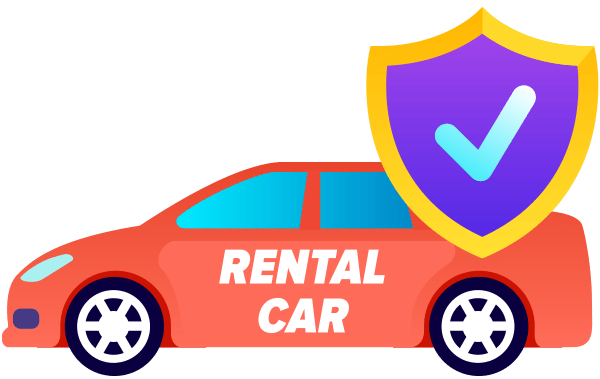Rental reimbursement coverage is a car insurance coverage option that helps pay for the cost of a rental car while the policyholder’s vehicle is being repaired after an accident. Rental reimbursement insurance can also pay for other transportation costs like cab fare and public transit expenses, depending on the insurer.
Key Things to Know About Rental Reimbursement Coverage
- Rental reimbursement coverage is optional.
- Coverage only applies when your own insurer is paying for repairs to your car.
- Rental reimbursement insurance can only be used after an accident, not for routine maintenance or the use of a rental car while on vacation.
- If another driver is at-fault, their liability insurance will cover the cost of your rental car.
- You can usually rent the car yourself and get reimbursed later, or you can let your insurer arrange the rental.
What Is Rental Reimbursement Coverage?
Rental car reimbursement insurance provides you with a rental car in the event your car needs repairs for a claim covered by your insurance policy. Depending on your insurer, it may also cover other transportation costs like cab fare and public transit expenses. Rental reimbursement insurance generally has no deductible.
Keep in mind that this coverage will only pay for a rental when your own insurer is paying for the repairs, generally under your collision or comprehensive insurance. In most cases, you can only purchase rental reimbursement insurance if you also have collision and comprehensive coverage.
It’s also important to note that your insurance company won’t pay for the rental indefinitely. Your policy will have a limit on how much it will pay per day and how much total it will pay per claim. The limit per claim might be a maximum dollar amount or a maximum number of days of coverage. Rental reimbursement coverage typically costs $2 to $15 per month, depending in part on the level of coverage on your policy.
Don’t confuse rental reimbursement insurance with the coverage you get when you rent a car for business or vacation travel. You can learn more about that coverage in our rental car insurance guide.
Rental Reimbursement Coverage When You're Not At-Fault
In many states, if another driver’s liability policy is covering repairs to your car, that driver’s insurance also is obligated to provide you with transportation while your car is being fixed. But even in cases where this is mandatory, the at-fault driver’s insurer may not be required to pay 100% of the rental cost. And since it may take several days or weeks to determine fault, you may need to pay out of pocket and get reimbursed later.
When You’re Ready To Rent A Car
With rental reimbursement coverage, you have two choices when you’re ready to rent a car after a covered accident:
- Car Rental Option 1: You can rent the car yourself, pay for it out of pocket and submit the bill to your insurance company for reimbursement. Some people prefer this option because it enables them to get the exact rental car they want, to take advantage of discount programs or to rack up travel rewards.
- Car Rental Option 2: You can let your insurance company arrange the car rental for you, which is usually the better option. Your insurer will also handle the paperwork and will pay the car rental company directly. Each insurer has a relationship with one of the major car rental companies and can usually get a better rate for you than you can get for yourself, which might translate into a larger car
Regardless of daily limits, your insurance policy is unlikely to pay for any extra fees such as a collision damage waiver. But purchasing insurance from the car rental company should not be necessary. In most cases, your own auto policy will cover the rental car while you drive it. The person handling your insurance claim can help you understand what’s covered and what isn’t while you’re renting. Plus, you may have other options for rental car insurance that also won’t cost you anything extra.
Is Rental Reimbursement Coverage Worth It?
Rental reimbursement coverage is worth it if you think that you are likely to be in a car accident and need a rental car within the next few years. If not, then you probably won’t get much from the coverage, even though it doesn’t cost very much.
It’s obviously hard to estimate how often you’ll get into an accident, but there is some information out there that can help. Allstate, for instance, estimates that its average customer only files a rental reimbursement claim once every 10 years. In other words, a typical driver will make 120 payments between accidents.
Based on this information, you can check the value of a potential policy by multiplying its monthly cost by 120 to see how much you’d pay over a 10-year period. If that totals more than your coverage limit (the maximum your insurance company will pay for your car rental), you’re probably not going to get the extra cost back in benefits.
For example, say that you pay $20 per month for your rental reimbursement insurance. In order to break even after 10 years, your coverage limit needs to be $2,400. If your limit is lower than that, then the additional coverage is likely not worth the cost.
Furthermore, these numbers reflect a scenario where your car requires time-consuming repairs, leaving you in need of alternative transportation for several weeks and maxing out your rental reimbursement benefits. If your car doesn’t require complicated repairs, your costs to rent a vehicle may not approach your policy limit. For example, a 7-10 day rental of an economy car may cost less than $300. This makes it even harder to break even on your coverage.
For most drivers, a better bet would be to put an equivalent amount into a savings account to help build an emergency fund.

WalletHub experts are widely quoted. Contact our media team to schedule an interview.